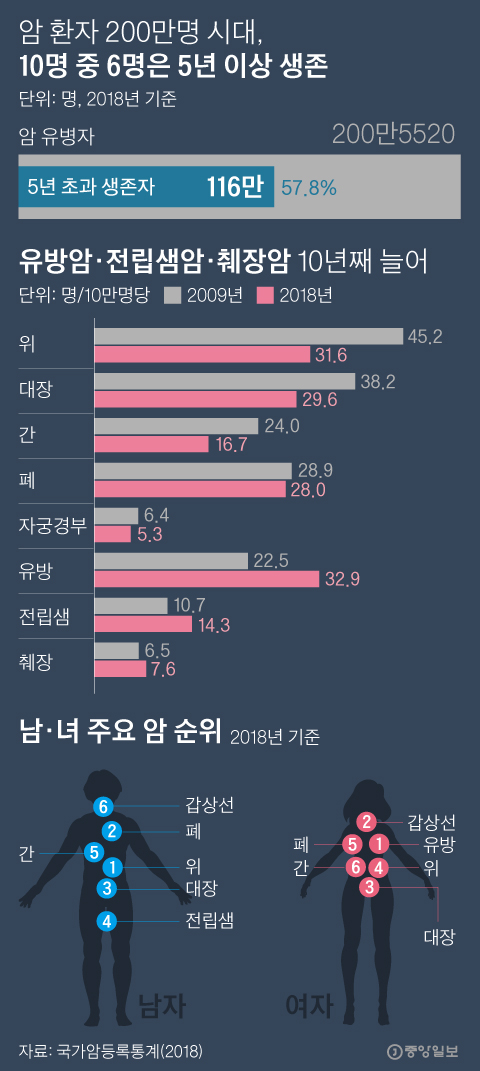The number of patients who have experienced cancer in Korea exceeded 2 million, and it was found that 1 out of 25 had overcome or are being treated. About 6 out of 10 cancer patients survived more than 5 years after being diagnosed with cancer. Among the major cancers, breast, pancreatic and prostate cancers have been increasing continuously for 10 years.
Breast cancer, prostate cancer, pancreatic cancer increased by 10 years
243,000 new cancer patients in 18 years,
According to the ‘2018 National Cancer Registration Statistics’ released on the 29th by the Ministry of Health and Welfare and the Central Cancer Registration Headquarters, the number of cancer victims (those who were diagnosed and treated or cured after 1999) in 2018 amounted to 2,5520,000 last year (1.8 million ), more than 140,000 people. As of 2018, about 1 out of 25 citizens (3.9%) are cancer victims. By gender, there are 400,000 more women (112,4463) than men (881057). In particular, the number of people over 65 years old is 9,06204, accounting for 12.3% of the total population (738,9477). About 12 out of 100 elderly people have or have had cancer.

At the age of 2 million cancer patients, 6 out of 10 survive for more than 5 years. Graphic = Reporter Park Kyung-min [email protected]
The number of cancer patients who survived more than 5 years after diagnosis was 1.16 million, 6 out of 10 (57.8%). It increased by 120,000 from the previous year (approximately 1.04 million).
The number of 2-5 year cancer patients requiring follow-up was 44,8263, 22.4% of the total cancer patients, and 39,7110, 19.8%, of cancer patients under 2 years requiring active cancer treatment.
The most common cancer among men and women was thyroid cancer (43,2932), stomach cancer (304,265), colon cancer (260,291), breast cancer (23,7771), and prostate cancer (91,6852). People), lung cancer (93,600 people) followed.
5-year survival rate 1.3 times that of 10 years ago
The 5-year relative survival rate of cancer patients diagnosed in the last 5 years (2014-2018) recorded 70.3%, 1.3 times that of cancer patients diagnosed 10 years ago (2001-2005) (54.1%).
By carcinoma, the survival rate was particularly high for thyroid cancer (100.1%), prostate cancer (94.1%), and breast cancer (93.3%), and liver cancer (37.0%), lung cancer (32.4%), gallbladder and other biliary cancer (28.8%), and pancreatic cancer. The survival rate of (12.6%) was relatively low. Carcinomas whose survival rate increased by more than 10% points compared to about 10 years ago (2001~2005) were gastric cancer, liver cancer, lung cancer, and prostate cancer. The 5-year relative survival rate by gender was higher in women (77.1%) than in men (63.8%), and it is estimated that thyroid cancer and breast cancer, which have a high survival rate, occur more in women than in men.
The total number of new cancer patients in 2018 was 24,3837, an increase of 3.5% (8290) from 2017 (23,5547). Gastric cancer was the most common cancer in all men and women in 2018, followed by thyroid cancer, lung cancer, colon cancer, breast cancer, liver cancer, and prostate cancer. By gender, gastric cancer was ranked first in men and breast cancer in women.

In 2017, a patient is walking in the hospice ward of the National Cancer Center in Goyang-si, Gyeonggi-do. Newsis
The cancer incidence rate (patients per 100,000) was 290.1 in 2018. The number of males increased by 0.2 from the previous year from 305.9 to 306.1, while the number of females increased by 5.8 from 282.7 to 288.5.
Effects of eating habits Breast, prostate, and pancreatic cancer steadily increase
Looking at the incidence rate by cancer type for about 10 years (2009-2018), gastric, colon, liver, lung, and cervical cancers have steadily decreased, but breast, prostate, and pancreatic cancers have increased.
“Colon, breast, prostate, and pancreatic cancer are all cancers related to westernized eating habits,” said Won Yeong-ju, head of the National Cancer Center Cancer Register. “Colorectal cancer is included in the national cancer screening, and the probability of detection before it becomes malignant increases and decreases. “The rest are still on the rise.” “Breast cancer is also being targeted for national screening, and the increase is slowing,” he explained.
If the Korean people survive to their life expectancy (83 years old), the probability of developing cancer was estimated at 37.4%. Men (80 years old) account for 2 out of 5 people (39.8%), and women (86 years old) account for 1 out of 3 people (34.2%).
Reporter Hwang Soo-yeon [email protected]
